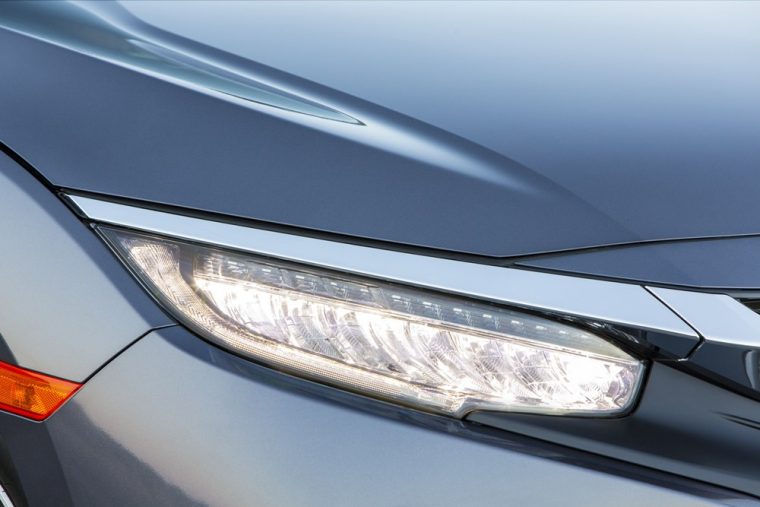The smart Trick of Hikari Led Headlight That Nobody is Discussing
Table of ContentsHikari Led Headlight for BeginnersGetting My Hikari Led Headlight To WorkHikari Led Headlight Things To Know Before You Get This
A headlamp system is needed to produce a low and a high beam, which might be produced by numerous pairs of single-beam lamps or by a set of dual-beam lights, or a mix of single-beam and dual-beam lights. High beams cast the majority of their light straight ahead, maximizing seeing range but producing excessive glare for safe use when other lorries are present on the road.Low beams have more stringent control of upward light, and direct the majority of their light down and either rightward (in right-traffic countries) or leftward (in left-traffic nations), to provide forward exposure without extreme glare or backdazzle. Low beam (dipped beam, passing beam, meeting beam) headlamps supply a distribution of light designed to offer forward and lateral lighting, with limitations on light directed towards the eyes of other road users to manage glare.


The majority of low-beam headlamps are specifically created for use on only one side of the roadway. Headlamps for usage in left-traffic countries have low-beam headlamps that "dip to the left"; the light is distributed with a downward/leftward bias to reveal the driver the roadway and signs ahead without blinding approaching traffic.

Not known Details About Hikari Led Headlight
Many tungsten (pre-halogen) European-code headlamps made in France by Cibi, Marchal, and Ducellier could be changed to produce either a left- or a right-traffic low beam by means of a two-position bulb holder. Due to the fact that wrong-side-of-road headlamps blind approaching motorists and do not adequately light the driver's method, and blackout strips and adhesive prismatic lenses reduce the safety efficiency of the headlamps, some countries need all vehicles registered or used on a permanent or semi-permanent basis within the country to be equipped with headlamps designed recommended you read for the correct traffic-handedness.
Automobile headlamps look at more info have been discovered unable to light up an assured clear range ahead at speeds above 60 km/h (40 miles per hour). It might be hazardous and, in a couple of locations, prohibited to drive above this speed in the evening. Some countries need automobiles to be equipped with daytime running lights (DRL) to increase the conspicuity of vehicles in movement during the daytime.
In copyright the DRL function needed on lorries made or imported considering that 1990 can be supplied by the headlamps, the fog lamps, steady-lit operation of the front turn signals, or by unique daytime running lamps. Functionally dedicated daytime running lights not including the headlamps are needed on all new automobiles initially offered in the European Union since February 2011.
Japan previously had bespoke lighting regulations comparable to the US requirements, however for the left side of the road. Nevertheless, Japan now sticks to the ECE requirement. The differences between the SAE and ECE headlamp standards are mainly in the amount of glare permitted towards other chauffeurs on low beam (SAE permits far more glare), the minimum amount of light needed to be tossed directly down the road (SAE needs more), and the particular areas within the great post to read beam at which minimum and maximum light levels are specified.
Below the line is intense, and above is dark. On the side of the beam dealing with away from approaching traffic (right in right-traffic countries, left in left-traffic countries), this cutoff sweeps or steps upward to direct light to road signs and pedestrians. SAE low beams may or might not have a cutoff, and if a cutoff is present, it may be of two different basic types: VOL, which is conceptually similar to the ECE beam in that the cutoff lies at the top of the left side of the beam and aimed slightly below horizontal, or VOR, which has the cutoff at the top of the best side of the beam and focused on the horizon.
Relative studies have consistently shown that there is little or no total safety advantage to either SAE or ECE beams; the 2 systems' approval and rejection by numerous countries is based mainly on which system is already in use. In North America, the style, efficiency and setup of all motor vehicle lighting gadgets are regulated by Federal and copyright Automobile Security Requirement 108, which integrates SAE technical standards.
7 Easy Facts About Hikari Led Headlight Described
US laws required sealed beam headlamps on all vehicles between 1940 and 1983, and other countries such as Japan, United Kingdom and Australia likewise made comprehensive usage of sealed beams. [] In a lot of other countries, and in the US considering that 1984, replaceable-bulb headlamps predominate. Headlamps should be kept in appropriate goal.
In the US, SAE standard headlamps are aimed without regard to headlamp mounting height. This offers lorries with high-mounted headlamps a seeing range benefit, at the expense of increased glare to drivers in lower vehicles - hikari led headlight. By contrast, ECE headlamp goal angle is connected to headlamp mounting height, to provide all vehicles approximately equal seeing distance and all drivers approximately equal glare.